
Belcher Islands
Encyclopedia

Archipelago
An archipelago , sometimes called an island group, is a chain or cluster of islands. The word archipelago is derived from the Greek ἄρχι- – arkhi- and πέλαγος – pélagos through the Italian arcipelago...
in Qikiqtaaluk Region, Nunavut
Nunavut
Nunavut is the largest and newest federal territory of Canada; it was separated officially from the Northwest Territories on April 1, 1999, via the Nunavut Act and the Nunavut Land Claims Agreement Act, though the actual boundaries had been established in 1993...
, Canada
Canada
Canada is a North American country consisting of ten provinces and three territories. Located in the northern part of the continent, it extends from the Atlantic Ocean in the east to the Pacific Ocean in the west, and northward into the Arctic Ocean...
. Located in Hudson Bay
Hudson Bay
Hudson Bay , sometimes called Hudson's Bay, is a large body of saltwater in northeastern Canada. It drains a very large area, about , that includes parts of Ontario, Quebec, Saskatchewan, Alberta, most of Manitoba, southeastern Nunavut, as well as parts of North Dakota, South Dakota, Minnesota,...
, the Belcher Islands are spread out over almost 3000 square kilometre. The hamlet of Sanikiluaq
Sanikiluaq, Nunavut
Sanikiluaq is a small Inuit hamlet located on the north coast of Flaherty Island in Hudson Bay, on the Belcher Islands, in the Qikiqtaaluk Region of Nunavut, Canada. Nuiyak School, with 23 staff, teaches Grades K-12, with 302 students enrolled. The principal is Tim Hoyt...
is on the north coast of Flaherty Island
Flaherty Island
Flaherty Island is an island in the Belcher Islands group in Hudson Bay in Qikiqtaaluk Region, Nunavut, Canada. The island has a very unusual shape....
and is the southernmost in Nunavut. Along with Flaherty Island, the other large islands are Kugong Island
Kugong Island
Kugong Island is an uninhabited island in Qikiqtaaluk Region, Nunavut, Canada. Located in Hudson Bay, it is the westernmost member of the Belcher Islands group. Along with Flaherty Island, Innetalling Island, and Tukarak Island, it is one of the four large islands in the group. Kugong Island and...
, Tukarak Island
Tukarak Island
Tukarak Island is an uninhabited island in Qikiqtaaluk Region, Nunavut, Canada. Located in Hudson Bay, it is a member of the Belcher Islands group. Along with Flaherty Island, Innetalling Island, and Kugong Island, it is one of the four large islands in the group.Other islands in the immediate...
, and Innetalling Island. Other major islands in the 1,500 island archipelago
Archipelago
An archipelago , sometimes called an island group, is a chain or cluster of islands. The word archipelago is derived from the Greek ἄρχι- – arkhi- and πέλαγος – pélagos through the Italian arcipelago...
are Moore Island
Moore Island
Moore Island is an uninhabited island in Qikiqtaaluk Region, Nunavut, Canada. It is a member of the Belcher Islands group in Hudson Bay.Other islands in the immediate vicinity include Kugong Island, Flaherty Island, Ney Island, and Renouf Island....
, Wiegand Island
Wiegand Island
Wiegand Island is an uninhabited island in Qikiqtaaluk Region, Nunavut, Canada. Located in Hudson Bay, it is a member of the Belcher Islands group.Other islands in the immediate vicinity include Renouf Island, Johnson Island, Loaf Island, and Bun Island....
, Split Island
Split Island
Split Island is an uninhabited island in Qikiqtaaluk Region, Nunavut, Canada. Located in Hudson Bay, it is a member of the Belcher Islands group....
, Snape Island
Snape Island
Snape Island is an uninhabited island in Qikiqtaaluk Region, Nunavut, Canada. Located in Hudson Bay, it is a member of the Belcher Islands group....
and Mavor Island
Mavor Island
Mavor Island is an uninhabited island in Qikiqtaaluk Region, Nunavut, Canada. Located in Hudson Bay, it is a member of the Belcher Islands group. Mavor Island forms the southeastern border of Fairweather Sound....
.
History
Before 1914 English-speaking cartographers knew very little about the Belcher Islands, which they showed on maps as specks, much smaller than their true extent. In that year a map showing them, drawn by George Weetaltuk, came into the hands of Robert Flaherty, and cartographers began to represent them more accurately.Geology
The geology of the Belcher Islands is ProterozoicProterozoic
The Proterozoic is a geological eon representing a period before the first abundant complex life on Earth. The name Proterozoic comes from the Greek "earlier life"...
; the exposed clastic sedimentary rocks, as well as volcanic igneous and carbonate
Carbonate
In chemistry, a carbonate is a salt of carbonic acid, characterized by the presence of the carbonate ion, . The name may also mean an ester of carbonic acid, an organic compound containing the carbonate group C2....
units record rifting and subsidence
Subsidence
Subsidence is the motion of a surface as it shifts downward relative to a datum such as sea-level. The opposite of subsidence is uplift, which results in an increase in elevation...
of the Superior craton
Superior craton
The Superior craton forms the core of the Canadian Shield at the heart of the North American continent. It extends from Quebec in the east to eastern Manitoba in the west...
during this period. There are two main volcanic sequences on the Belcher Islands called the Eskimo and overlying Flaherty volcanics. These volcanics form part of the Circum-Superior Belt
Circum-Superior Belt
The Circum-Superior Belt is a widespread Paleoproterozoic large igneous province in the Canadian Shield of Northern, Western and Eastern Canada. It extends more than from northeastern Manitoba through northwestern Ontario, southern Nunavut to northern Quebec...
.
Flora
Other than in valley regions, trees cannot grow on the islands because of a lack of adequate soil.Fauna
The main wildlife consists of belugas, walrusWalrus
The walrus is a large flippered marine mammal with a discontinuous circumpolar distribution in the Arctic Ocean and sub-Arctic seas of the Northern Hemisphere. The walrus is the only living species in the Odobenidae family and Odobenus genus. It is subdivided into three subspecies: the Atlantic...
, reindeer
Reindeer
The reindeer , also known as the caribou in North America, is a deer from the Arctic and Subarctic, including both resident and migratory populations. While overall widespread and numerous, some of its subspecies are rare and one has already gone extinct.Reindeer vary considerably in color and size...
, and snowy owls
Snowy Owl
The Snowy Owl is a large owl of the typical owl family Strigidae. The Snowy Owl was first classified in 1758 by Carolus Linnaeus, the Swedish naturalist who developed binomial nomenclature to classify and organize plants and animals. The bird is also known in North America as the Arctic Owl, Great...
all which can be seen on the island year round. There is also a wide variety of fish
Fish
Fish are a paraphyletic group of organisms that consist of all gill-bearing aquatic vertebrate animals that lack limbs with digits. Included in this definition are the living hagfish, lampreys, and cartilaginous and bony fish, as well as various extinct related groups...
that can be caught such as Arctic Char
Arctic char
Arctic char or Arctic charr is both a freshwater and saltwater fish in the Salmonidae family, native to Arctic, sub-Arctic and alpine lakes and coastal waters. No other freshwater fish is found as far north. It is the only species of fish in Lake Hazen, on Ellesmere Island in the Canadian Arctic...
, Cod
Cod
Cod is the common name for genus Gadus, belonging to the family Gadidae, and is also used in the common name for various other fishes. Cod is a popular food with a mild flavor, low fat content and a dense, flaky white flesh. Cod livers are processed to make cod liver oil, an important source of...
Capelin
Capelin
The capelin or caplin, Mallotus villosus, is a small forage fish of the smelt family found in the Atlantic and Arctic oceans. In summer, it grazes on dense swarms of plankton at the edge of the ice shelf. Larger capelin also eat a great deal of krill and other crustaceans...
, Lump Fish
Lumpsucker
Lumpsuckers or lumpfish are mostly small scorpaeniform marine fish of the family Cyclopteridae. They are found in the cold waters of the Arctic, North Atlantic, and North Pacific oceans...
, and Sculpin
Sculpin
A Sculpin is a fish that belongs to the order Scorpaeniformes, suborder Cottoidei and superfamily Cottoidea, that contains 11 families, 149 genera, and 756 species...
.

